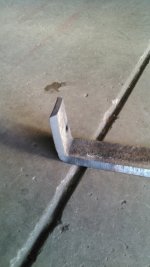Walker1
Bronze Member
I need to replace the cutting edge on the bucket of my Case 530. The original was a 1/2"x 3" single bevel, weld on cutting edge. I hunk 3" is a little too skinny, and 1/2" is a little too thin. I am hoping to find a 5/8"x4"or5" edge to use. The original has bent up sides, which I like, but don't like the price and they seem to be not available in bigger dimensions.
I took a scrap piece of cutting edge and bent one side hot by clamping the end to the table and bending a 90. It is a bit too broad of a curve. After bending, I quenched it. I then heated the other end and bent it in my ironworker (wont bend cold). The bend radius is good. I let this one just sit and cool. I am curious which one will retain more of its abrasion resistant qualities. On the second bend I put a firebrick on the dye to see how well I could restraint the heat from creeping down the bar and annealing it. It did pretty well, so I will likely do that to keep the heat is a fairly small area.
Is anyone aware of the thermal properties of AR, and how to best get them back after heating. I can't seem to find anything concrete on the net.
Thanks,
I took a scrap piece of cutting edge and bent one side hot by clamping the end to the table and bending a 90. It is a bit too broad of a curve. After bending, I quenched it. I then heated the other end and bent it in my ironworker (wont bend cold). The bend radius is good. I let this one just sit and cool. I am curious which one will retain more of its abrasion resistant qualities. On the second bend I put a firebrick on the dye to see how well I could restraint the heat from creeping down the bar and annealing it. It did pretty well, so I will likely do that to keep the heat is a fairly small area.
Is anyone aware of the thermal properties of AR, and how to best get them back after heating. I can't seem to find anything concrete on the net.
Thanks,
